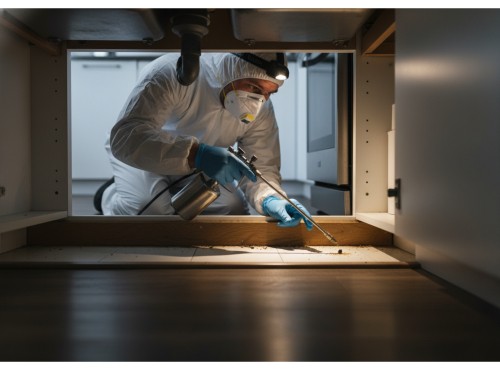DIY Approaches Toronto Residents Commonly Use
Toronto residents often try basic at-home steps before contacting a professional. Some approaches offer short-term relief, while others create gaps that allow insects, rodents, and wildlife to return. PMPs across the city frequently encounter situations where a do-it-yourself attempt slowed activity but didn’t remove the source.
a. Store-Bought Sprays for Insects
People often apply retail aerosol sprays for ants, spiders, roaches, and small crawling insects. These products can kill insects on contact, but they do not reach hidden harbourage sites such as wall voids, under appliances, or inside cupboards where activity continues.
b. Over-the-Counter Baits
Ant and cockroach baits from hardware stores may help when placed correctly. The challenge is placement: baits work only when positioned along foraging routes. Incorrect placement, such as putting baits in open areas away from walls, usually leads to poor uptake.
c. Plug-In Ultrasonic Devices
Some Toronto homeowners try ultrasonic devices to repel rodents. Research from the University of Arizona and several U.S. extension programs (e.g., Nebraska Extension) has shown that rodents often ignore these devices or adapt quickly.¹ ²
d. DIY Rodent Traps
Snap traps and glue boards are common in rental units and older homes near Dufferin & Bloor, Queen & Bathurst, or Jarvis & Carlton, where mouse activity is routine. While traps catch individual mice, they do not close entry gaps. As a result, new mice continue to enter from basements, garages, or exterior vents.
e. Internet Tutorials for Wasp and Hornet Nests
Toronto technicians regularly caution against DIY nest removal. Disturbing a nest can provoke defensive behaviour. Health Canada warns that outdoor nests should be managed with caution due to stinging risks, especially for children and seniors.³
f. Wildlife Attempts: Raccoons, Squirrels, and Skunks
Residents sometimes try to block holes with boards or mesh. In many cases, wildlife is still inside the attic or chimney. This leads to property damage as animals tear siding or vents to escape. Ontario regulations also require humane practices and controlled release distances.
Why DIY Results Often Fall Short
a. Hidden Activity Inside Structural Voids
Toronto’s older housing stock has wall gaps, pipe chases, and attic voids where insects and rodents travel. Most DIY tools cannot reach these hidden areas.
b. Lack of Monitoring Tools
Professionals use monitoring stations, moisture readers, and inspection lighting to locate hot spots. Without these tools, residents often treat the wrong points.
c. Misidentification of Species
Many insects look similar.
Examples:
- Carpenter ants vs pavement ants
- German cockroaches vs wood roaches
- Cluster flies vs houseflies
Misidentification leads to the wrong treatment.
d. Gaps That Reopen
Sealing vents, doors, or wall gaps without reinforcing the material often leads to re-entry. Wildlife can remove weak screening. Mice can enter holes as small as a dime.
Safe DIY Steps That Do Work
These steps are considered helpful by PMPs across Toronto and can support professional work:
a. Sanitation and Garbage Control
- Keep garbage sealed.
- Clean food debris behind stoves, fridges, and dishwashers.
- Store dry food in sealed containers.
b. Moisture Reduction
Fix minor leaks under sinks and around dishwashers. Many insects thrive in damp zones.
c. Basic Sealing of Gaps
Residents can apply steel wool and caulking around small utility gaps inside the home until a full exclusion visit is scheduled.
d. Vacuuming for Bed Bugs
Vacuuming mattresses, bed frames, and baseboards reduces numbers before thermal or chemical treatment.
e. Removing Attractants for Wildlife
Secure outdoor garbage, clear fallen fruit in yards, and remove accessible food for birds or pets. These steps reduce visits from raccoons, skunks, and squirrels.
When Toronto Residents Usually Call a Professional
Based on what technicians report citywide, people typically call a company when:
- Activity returns after several DIY tries
- Droppings continue to appear in kitchens or basements
- Scratching noises increase in attics
- Wasp nests grow larger
- Smells begin to develop in sealed voids
- Commercial properties receive complaints or inspection warnings
At this point, PMPs perform full inspections, place monitoring devices, apply targeted treatments, and complete exclusion work that DIY tools cannot replicate.









